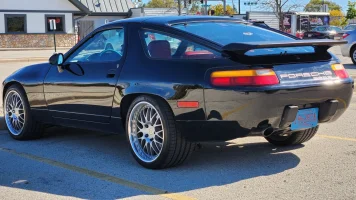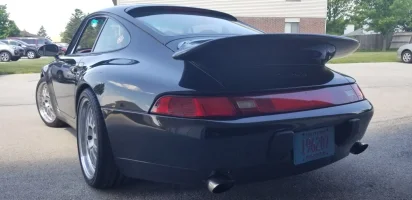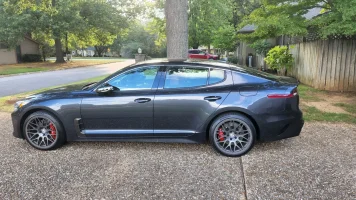Brichinelo
Stinger Enthusiast
- Joined
- Sep 19, 2021
- Messages
- 949
- Reaction score
- 585
- Points
- 98
You got any pics of your wheel setup and what size rims ?Exactly the ones i have. Price/pound ratio is awsome and look great on stinger.

You got any pics of your wheel setup and what size rims ?Exactly the ones i have. Price/pound ratio is awsome and look great on stinger.
I bent my 20 inch black rim a while back and had to get it professionally repaired. I asked this question a while back about to how to combat potholes and messed up roads and really didn’t get a clear consensus. I just sold my oem 18 inch setup so I’m left with my 20s. If I did want to do 19s all the way around (square ) what would be the best tire setup. Currently sitting at 245/35/20. And I love the info and knowledge on this thread. Keep it goingBut Those stiff sidewall comes with penalties:
1. Weight. again rears its ugly head. There is just no way around this. More load handling out of less sidewall height means more materials and reinforcements. Look up any of the more popular performance tires and you'll see this for yourself. All else being equal, lower profile (less sidewall) will invariably carry a lower load rating, meaning their cannot sustain the same load as a higher profile tire of the same series/dia/width. And... when you do find another tire that does have an equivalent load rating as the higher profile tire, it will be heavier.
2. Reduce tire compliance. A 20" tire on a Stinger will have to be ultra low profile in order to maintain the same rolling diameter as an 18" tire. This means 255/30R20 vs. 255/40R18. When a tire has that little sidewall - and having to be ultra stiff to carry the same load rating - it simply will not flex at all. While this might not be a big deal on a billiard table smooth race track, most of us drive on roads that are far less forgiving. Over rough pavement and over larger undulations, a tire needs a certain amount of compliance in order to stay adhered to the road surface and to maintain grip. Too stiff a sidewall and too little compliance will simply make the tire bound off the pavement and lose contact/grip. The best tire compound in the world ain't gonna do you much good when it is in the air.
Also, some compliance is necessary for optimum accel and braking. Most folks familiar with drag racing know this.
3. NVH (Noise, Vibration, and Harshness). Short stiff sidewalls will transmit more NVH (Noise, Vibration, and Harshness) up the wheel, thru the suspension and into the cabin. That means more road noise. That also means your suspension will be more stressed and have to work harder to dampen the additional movement that would have been otherwise absorbed by a more compliant tire.
4. Road hazards. This brings us inexorably back to the topic of this thread. There is no escaping the fact that your 20" rim - with a 255/30R20 tire - is sitting some 2" off the pavement. Now imagine that wheel/tire hitting a pothole. Even at modest speed of say 60mph, that awfully small "crumple zone" will have a tough time absorbing that impact, before the suspension has a chance to react. Little surprise that Stinger/G70 forums and FB pages are constantly littered with folks posting their dented/crack rims.
Looking good . Highly considering this setup after reading this thread. Square ? And now lowered or anything right ?245/40-18 with 8.5 wide wheels.View attachment 78084
I had an '07 FZ1, set up for a Monokey top case and Givi V35 panniers. Excellent sport tourer.<<<--- FZ1 with luggage and gps - poor man's sport tourer.
Out of the available colors for TFR, bright silver is a great match with that blue.245/40-18 with 8.5 wide wheels.View attachment 78084
Correct, square setup. And it's on ark gt-f springs. But with my weight reduction "mods", i think, i will need more aggressive springs, to bring it down again.Looking good . Highly considering this setup after reading this thread. Square ? And now lowered or anything right ?
I wish they were little brighter. They are light grey, forgot the name for that color.Out of the available colors for TFR, bright silver is a great match with that blue.
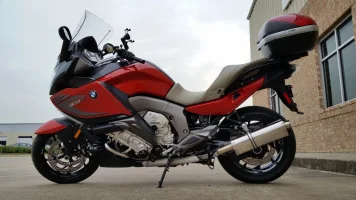
Storm Gray, I think. Mine is called just "Copper". I almost went with the Gun Metal, which my son originally preferred. But after looking at tons of different online pics - at different angles - of all 3 colors on similar red color cars, we went with the Copper.I wish they were little brighter. They are light grey, forgot the name for that color.
I personally love the square look. Looking nice. No problem with the springs even on 18s ? Would springs be better on 18s ?Correct, square setup. And it's on ark gt-f springs. But with my weight reduction "mods", i think, i will need more aggressive springs, to bring it down again.
The only time I've ever hit potholes hard is when I simply couldn't see them, such as when the hole is filled with water and it is both dark and raining. No contrast with the rest of the road at all.Treat the street like a slalom course, avoid the potholes using full width of your lane (and adjacent if not occupied). That's what I do here. Even slow down for rail road tracks.
With the stock wheels, especially the heavy 19"s (which could weight as much as 35 lbs each), the stock suspension is rather soft. This is an artifact of having so little tire compliance with the very low profile stock 19" tires, that Kia had to soften the shock and spring in order to get sufficiently smooth ride quality. With a heavy wheel and soft springs and shock, the system is underdamped. This means the articulation of the unsprung mass tend to oscillate after a perturbation (such as hitting a bump in the road), like the blue line in the below graph, albeit exaggerated.I personally love the square look. Looking nice. No problem with the springs even on 18s ? Would springs be better on 18s ?

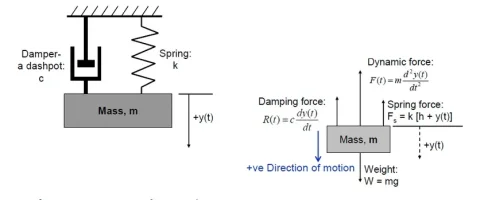
Thanks for the school lesson my guy. Very much appreciated. To Google I go.With the stock wheels, especially the heavy 19"s (which could weight as much as 35 lbs each), the stock suspension is rather soft. This is an artifact of having so little tire compliance with the very low profile stock 19" tires, that Kia had to soften the shock and spring in order to get sufficiently smooth ride quality. With a heavy wheel and soft springs and shock, the system is underdamped. This means the articulation of the unsprung mass tend to oscillate after a perturbation (such as hitting a bump in the road), like the blue line in the below graph, albeit exaggerated.
So, now you install a set of tires that are 15 lbs lighter vs. the stock 19s. That is 42% lighter wheel, or 25% lighter wheel/tire assembly. Less mass for the same spring and shock to control means the system is able to suppress the perturbation quicker... to perhaps the red line.
Even without changing the shocks, reducing unsprung mass means the shocks have that much less inertial energy to absorb with each articulation. You have, in effect, better matched the wheel weight to an otherwise underdamped shock.
Now, you install lowering springs that are 15% stiffer, which means for every inch of suspension travel, the spring exerts 15% more force to counter that suspension movement. This can improve the perturbation response down to the orange line.

In reality, the changes are not as drastic. This graph is just an example damping graph I pulled off of Google for illustration purposes only. That said, both reducing unsprung weight and increasing the spring rate will most definitely improve suspension control in the Stinger's case.
The rest of the suspension doesn't know what diameter wheel you have on. All they feel is the unsprung mass that they have to control. The lighter that mass is, the more effective they are able to control the movement, the quicker they are able to re-establish stability. Again, all else being equal, lighter is always better.
Google "damped mass spring system", and you can read more about these very fundamental principles that every engineering student has to learn.

